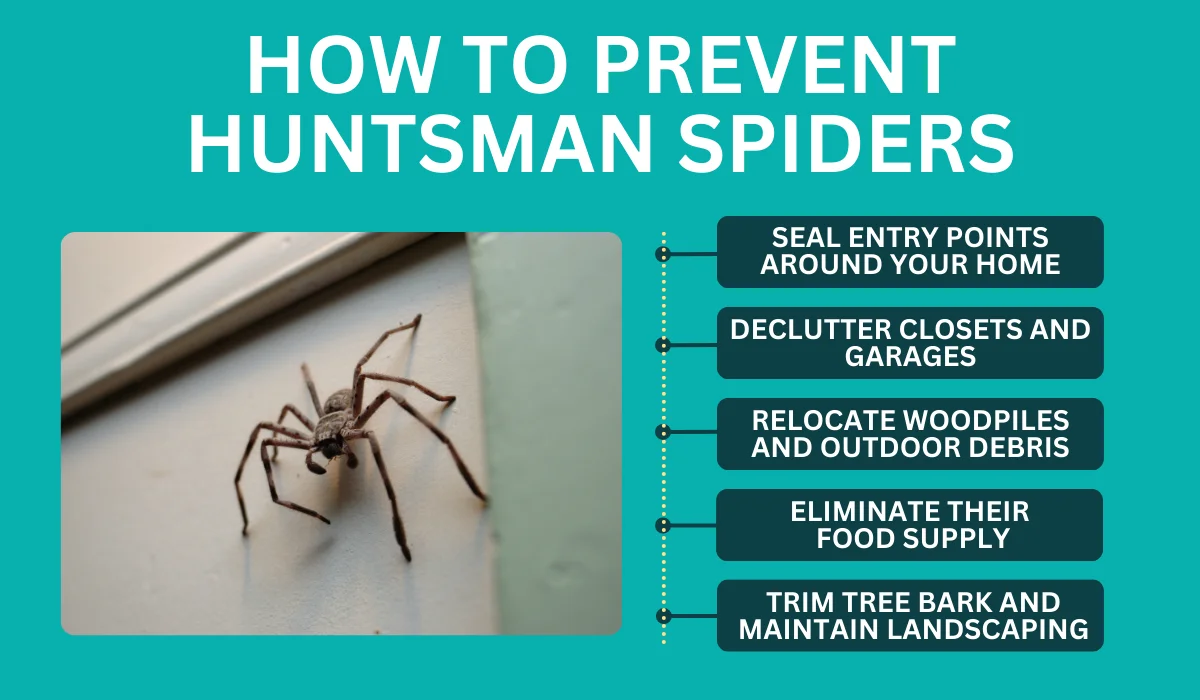Huntsman Spiders in Florida: Facts, Identification, & Prevention
If you’ve ever come face-to-face with a large spider zipping across your garage wall, there’s a good chance you’ve spotted a huntsman spider. Known for their long legs and surprising speed, these arachnids might look scary—but they’re more helpful than harmful.
Let’s break down what you need to know about the huntsman spider in Florida.
Key Takeaways
- The huntsman spider is a large Florida spider that hunts pests like cockroaches instead of spinning webs.
- Long legs, black spots, and a flat body help identify this type of spider with a five-inch leg span.
- Most bites happen when disturbed and cause mild, short-term pain without serious allergic reactions or lasting damage.
- Pest control professionals can help Florida homeowners stay pest-free with expert spider prevention and safe treatment plans.
What Is a Huntsman Spider?
The huntsman spider is one of the most recognizable spider species in Florida.
Native to Asia, this pantropical huntsman spider has adapted well to warm, humid climates like ours in South Florida. It's part of the Sparassidae family, commonly known as giant crab spiders or wood spiders.
These spiders are sometimes mistaken for other arthropods because of their size and crab-like appearance. But what really sets them apart is their hunting behavior.
Rather than building webs to trap prey, they actively hunt, feeding on everything from cockroaches to small reptiles.
How to Identify the Huntsman Spider
Here’s how to spot the huntsman spider if it turns up in or around your home:
Features | Description |
Size | Leg span can reach up to 5 inches or even larger |
Legs | Long, angled legs |
Body | Flattened body |
Color & Markings | Usually brown or tan with black spots or dark streaks |
Egg Sac | Females carry the egg sac underneath |
This spider species is often confused with other arachnids.
Wolf spiders are generally hairier and more grounded, while banana spiders are web-builders with bright colors. The brown recluse spider, though rarely found in Florida, has a violin-shaped marking and is far more dangerous.
Are Huntsman Spiders Dangerous?
While the huntsman spider looks intimidating, it’s not considered dangerous to humans. Most bites only happen when the spider is disturbed—like when someone picks it up by accident—and the effects are minor.
In a study of confirmed huntsman spider bites, every case involved some pain, but it usually lasted just a few minutes. Redness, swelling, or small puncture marks were also common, but serious symptoms were rare. There were no reports of allergic reactions or skin damage.
Unlike the brown recluse spider, which can cause serious tissue damage, its bite is more about the initial sting than any lasting effects. Still, if a bite causes discomfort or doesn’t get better, it’s best to check in with a doctor.
How to Prevent Huntsman Spiders

If you want to stay pest-free, prevention is key. Here’s how to keep the huntsman spider and other arachnids outside where they belong:
Seal Entry Points Around Your Home
Huntsman spiders are experts at slipping through small openings thanks to their flattened bodies.
Gaps around windows, door frames, and even utility lines can become access points. Using silicone caulk or weatherstripping to seal up those crevices helps shut the door—literally—on spider intrusions.
Declutter Closets and Garages
Dark, quiet areas like closets and garages are prime real estate for the huntsman spider.
If you've got cardboard boxes stacked in a corner or old holiday decorations you haven’t touched in years, you're basically rolling out the welcome mat.
Relocate Woodpiles and Outdoor Debris
Woodpiles, leaf litter, and other debris provide the perfect hiding spots for huntsman spiders during the day. If these materials are too close to your home, you're increasing the odds they'll make the jump indoors.
Keep firewood stored off the ground and at least 20 feet from your house whenever possible.
Eliminate Their Food Supply
One of the main reasons huntsman spiders wander into homes is to chase after prey—especially cockroaches. Keeping your indoor pest populations under control means there’s less incentive for the huntsman to move in.
Regular pest control treatments and good sanitation habits are the best ways to keep those food sources off the menu.
Trim Tree Bark and Maintain Landscaping
Overgrown mulch beds, loose tree bark, and dense shrubbery near your foundation all give spiders extra places to hide and breed. Trimming back vegetation and using a rake to keep mulch fresh can reduce these harborage zones.
It’s a small maintenance task that goes a long way toward keeping your yard and home spider-free.
Don’t Wait for the Next Surprise Visitor
At Native Pest Management, we offer expert spider control and general pest management to help you stay pest-free year-round. Whether you’re seeing one huntsman or a growing population of pests, we’ll get your home back under control quickly and safely.
Our team specializes in Florida’s unique climates and pest challenges, and all of our treatments are family- and pet-friendly.
Have questions?
Think you’ve spotted a giant huntsman or other large spider in your home?
Give us a call. Our pest control service is here to help.
